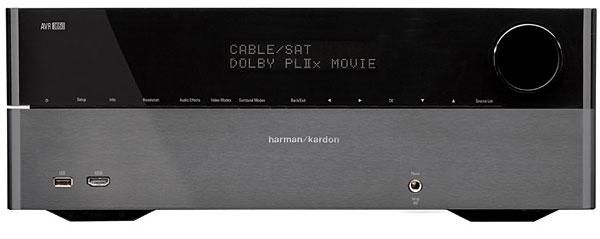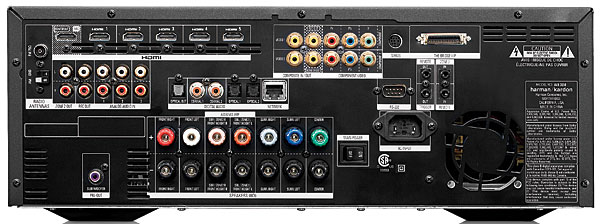Just curious what happened to HK in their power department. I know all my past HK receivers (avr525,avr325) were way underated than the specs given. Has HK gone the cheap route now. Would the Marantz product be a better choice and what makes your personal decision between the two.
Harman Kardon AVR 3650 A/V Receiver

The home theater system’s beating heart is the audio/video receiver. It supports a heroic workload: routing video and audio signals from source components to display and speakers, gussying up the video, decoding audio formats, massaging audio signals with listening modes, cabalistically correcting room acoustics—and last but not least, performing the heavy lifting necessary to drive loudspeakers. The final item on that list is among the AVR’s most significant attributes. But in the race to jam in as many features as possible, amplification is in danger of becoming an afterthought. In Harman Kardon’s AVR 3650, the top model in its new receiver line, the manufacturer took the road less often traveled and acts more like a high-end boutique manufacturer than a mass marketer. It went the extra mile to make this AVR sound great and rigorously stripped it of back-panel clutter. The result offers comfort to the music lover who cares about the fundamentals of performance.
Two-Tone Look
The Harman Kardon AVR 3650 has a distinctive look carried over from previous lines. You’d never mistake a Harman A/V receiver for anyone else’s. The front panel is dramatically bisected into a shiny black top half and a matte gray bottom half, divided by a skinny strip of nearly invisible buttons. The front-panel HDMI and USB jacks are so well camouflaged that you might easily miss them as well. The volume knob to the right of the white fluorescent display is encircled in white light. Viewed from off center, it looks like a bright crescent moon on a clear evening. While you can dim the front-panel display in three stages or turn it off, you can only set the volume knob backlighting to on or off.
Connectivity isn’t what you’d expect in an A/V receiver that sells for a thousand bucks. It’s considerably reduced. Harman isn’t the first manufacturer to omit S-video, and forward-looking videophiles would probably forgive cutting back composite video to two inputs and two outputs. Really, how much legacy junk do you need in your rack?
But while Harman provides two component video inputs, it has omitted the component video output, which you may miss if you use an older pre-HDMI HDTV or component video for a long projector cable run. For analog audio, there are three stereo inputs and two stereo outputs, but no multichannel ins or multichannel preamp outs, so forget about plugging in an older disc player or using this AVR as a surround processor. If you’re connecting an iPod or iPhone, you may use The Bridge IIIP, a $129 accessory. The AVR 3650 doesn’t support the iPad tablet either way.

Harman Kardon mixes licensed and proprietary technologies in a mostly pragmatic way. This HDMI 1.4a AVR supports 3D. Video processing is Faroudja DCDi. You can set resolution, video processing mode, and parameters such as film-mode detect and black level separately for each input. The graphic user interface is generated in your choice of output resolution up to 1080p.
On the audio side, the product supports DTS-HD Master Audio and Dolby TrueHD lossless surround—nowadays, we expect no less—with the welcome addition of Dolby Volume for volume leveling and dynamic range control. Listening modes include Dolby Pro Logic IIz, which offers the possibility of redirecting the sixth and seventh amp channels to height enhancement. Harman supplements DPLII with its own Logic 7 listening mode, with movie, music, and game settings; plus Harman Virtual Speaker, which simulates 5.1-channel effects from two speakers; and Harman Headphone, another virtual surround mode. Auto setup and room correction are present in Harman’s own EZSet/EQ, with results I’ll describe later.
The graphic user interface is modern and good looking—once you find the button that activates it. The minimal printed manual that came with my sample instructs you to look for a Setup button on the remote control, but the remote button that triggers the GUI is labeled AVR. Harman has since fixed the manual. Incidentally, the full manual (available as a PDF on Harman’s Website) correctly identifies the remote’s AVR button as the GUI entry point. The remote itself is big, a good 10 inches long, with bright white backlighting triggered by a dedicated button. Controls are well differentiated by size, shape, and layout. The lozenge-shaped key for volume up/down is easy to find and a hair over an inch long. This is a sleek, well-thought-out remote, and I enjoyed having it by my side during the demos.
Setup with EZSet/EQ and the included setup microphone was straightforward. The program listed speaker distances in rounded-off feet but was otherwise in the ballpark. It correctly pegged the size (meaning bass capability) of my reference speakers as large, which is standard procedure for most auto setups. I changed this to small with an 80-hertz crossover, which is standard procedure for me. The default setting for Dolby Volume was low; I switched it off but selectively invoked it on some movie (never music) content. I always prefer to hear music with the dynamics the artist intended.
Associated equipment included five Paradigm Reference Studio 20 v.4 speakers and an Oppo BDP83SE universal disc player.
Politesse
In movie demos, with EZSet/EQ engaged, the AVR 3650 exhibited a smooth, laid-back sound that was slightly reticent in the upper midrange compared with most A/V receivers that visit my equipment rack. This took the edge off aggressive action-movie effects. While it didn’t severely dull vocals, it did require me to play soundtracks at moderate to loud volumes for optimum vocal clarity. Dynamics were good: The AVR had no trouble driving my reference speakers, which are of average sensitivity, to high output levels.
- Log in or register to post comments

























































